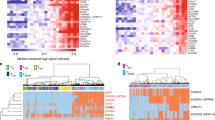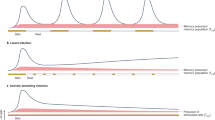Abstract
A major unanswered question is what distinguishes the majority of activated CD8 T cells that die after an acute viral infection from the small fraction (5–10%) that survive to become long-lived memory cells. In this study we show that increased expression of the interleukin 7 receptor α-chain (IL-7Rα) identifies the effector CD8 T cells that will differentiate into memory cells. IL-7Rhi effector cells contained increased amounts of antiapoptotic molecules, and adoptive transfer of IL-7Rhi and IL-7Rlo effector cells showed that IL-7Rhi cells preferentially gave rise to memory cells that could persist and confer protective immunity. Thus, selective expression of IL-7R identifies memory cell precursors, and this marker may be useful in predicting the number of memory T cells generated after infection or immunization.
This is a preview of subscription content, access via your institution
Access options
Subscribe to this journal
Receive 12 print issues and online access
$209.00 per year
only $17.42 per issue
Buy this article
- Purchase on Springer Link
- Instant access to full article PDF
Prices may be subject to local taxes which are calculated during checkout





Similar content being viewed by others
References
Kaech, S.M., Wherry, E.J. & Ahmed, R. Effector and memory T-cell differentiation: implications for vaccine development. Nat. Rev. Immunol. 2, 251–262 (2002).
Busch, D.H., Pilip, I.M., Vijh, S. & Pamer, E.G. Coordinate regulation of complex T cell populations responding to bacterial infection. Immunity 8, 353–362 (1998).
Murali-Krishna, K. et al. Counting antigen-specific CD8 T cells: a reevaluation of bystander activation during viral infection. Immunity 8, 177–187 (1998).
Kaech, S.M., Hemby, S., Kersh, E. & Ahmed, R. Molecular and functional profiling of memory CD8 T cell differentiation. Cell 111, 837–851 (2002).
Wherry, E.J. et al. Lineage relationship and protective immunity of memory CD8 T cell subsets. Nat. Immunol. 4, 225–234 (2003).
Becker, T.C. et al. Interleukin 15 is required for proliferative renewal of virus-specific memory CD8 T cells. J. Exp. Med. 195, 1541–1548 (2002).
Gett, A.V., Sallusto, F., Lanzavecchia, A. & Geginat, J. T cell fitness determined by signal strength. Nat. Immunol. 4, 355–360 (2003).
Goldrath, A.W. et al. Cytokine requirements for acute and Basal homeostatic proliferation of naive and memory CD8+ T cells. J. Exp. Med. 195, 1515–1522 (2002).
Grayson, J.M., Zajac, A.J., Altman, J.D. & Ahmed, R. Cutting edge: increased expression of Bcl-2 in antigen-specific memory CD8+ T cells. J. Immunol. 164, 3950–3954 (2000).
Kieper, W.C. et al. Overexpression of interleukin (IL)-7 leads to IL-15-independent generation of memory phenotype CD8+ T cells. J. Exp. Med. 195, 1533–1539 (2002).
Ku, C.C., Murakami, M., Sakamoto, A., Kappler, J. & Marrack, P. Control of homeostasis of CD8+ memory T cells by opposing cytokines. Science 288, 675–678 (2000).
Schluns, K.S., Williams, K., Ma, A., Zheng, X.X. & Lefrancois, L. Cutting edge: requirement for IL-15 in the generation of primary and memory antigen-specific CD8 T cells. J. Immunol. 168, 4827–4831 (2002).
Tan, J.T. et al. Interleukin (IL)-15 and IL-7 jointly regulate homeostatic proliferation of memory phenotype CD8+ cells but are not required for memory phenotype CD4+ cells. J. Exp. Med. 195, 1523–1532 (2002).
Maraskovsky, E. et al. Impaired survival and proliferation in IL-7 receptor-deficient peripheral T cells. J. Immunol. 157, 5315–5323 (1996).
Peschon, J.J. et al. Early lymphocyte expansion is severely impaired in interleukin 7 receptor-deficient mice. J. Exp. Med. 180, 1955–1960 (1994).
Rathmell, J.C., Farkash, E.A., Gao, W. & Thompson, C.B. IL-7 enhances the survival and maintains the size of naive T cells. J. Immunol. 167, 6869–6876 (2001).
Schluns, K.S., Kieper, W.C., Jameson, S.C. & Lefrancois, L. Interleukin-7 mediates the homeostasis of naive and memory CD8 T cells in vivo. Nat. Immunol. 1, 426–432 (2000).
Sudo, T. et al. Expression and function of the interleukin 7 receptor in murine lymphocytes. Proc. Natl. Acad. Sci. USA 90, 9125–9129 (1993).
Tan, J.T. et al. IL-7 is critical for homeostatic proliferation and survival of naive T cells. Proc. Natl. Acad. Sci. USA 98, 8732–8737 (2001).
Vella, A., Teague, T.K., Ihle, J., Kappler, J. & Marrack, P. Interleukin 4 (IL-4) or IL-7 prevents the death of resting T cells: stat6 is probably not required for the effect of IL-4. J. Exp. Med. 186, 325–330 (1997).
von Freeden-Jeffry, U. et al. Lymphopenia in interleukin (IL)-7 gene-deleted mice identifies IL-7 as a nonredundant cytokine. J. Exp. Med. 181, 1519–1526 (1995).
Harrington, L.E., Galvan, M., Baum, L.G., Altman, J.D. & Ahmed, R. Differentiating between memory and effector CD8 T cells by altered expression of cell surface O-glycans. J. Exp. Med. 191, 1241–1246 (2000).
Hamann, D. et al. Phenotypic and functional separation of memory and effector human CD8+ T cells. J. Exp. Med. 186, 1407–1418 (1997).
Voehringer, D. et al. Viral infections induce abundant numbers of senescent CD8 T cells. J. Immunol. 167, 4838–4843 (2001).
Boothby, M., Mora, A.L. & Stephenson, L.M. Lymphokine-dependent proliferation of T-lymphoid cells: regulated responsiveness and role in vivo. Crit. Rev. Immunol. 21, 487–522 (2001).
Rathmell, J.C. & Thompson, C.B. Pathways of apoptosis in lymphocyte development, homeostasis, and disease. Cell 109, S97–107 (2002).
van Engeland, M., Nieland, L.J., Ramaekers, F.C., Schutte, B. & Reutelingsperger, C.P. Annexin V-affinity assay: a review on an apoptosis detection system based on phosphatidylserine exposure. Cytometry 31, 1–9 (1998).
Wang, X.Z. et al. Virus-specific CD8 T cells in peripheral tissues are more resistant to apoptosis than those in lymphoid organs. Immunity 18, 631–642 (2003).
Schluns, K.S. & Lefrancois, L. Cytokine control of memory T-cell development and survival. Nat. Rev. Immunol. 3, 269–279 (2003).
Prlic, M., Lefrancois, L. & Jameson, S.C. Multiple choices: regulation of memory CD8 T cell generation and homeostasis by interleukin (IL)-7 and IL-15. J. Exp. Med. 195, F49–52 (2002).
Jameson, S.C. Maintaining the norm: T-cell homeostasis. Nat. Rev. Immunol. 2, 547–556 (2002).
Van Parijs, L. & Abbas, A.K. Homeostasis and self-tolerance in the immune system: turning lymphocytes off. Science 280, 243–248 (1998).
Plas, D.R., Rathmell, J.C. & Thompson, C.B. Homeostatic control of lymphocyte survival: potential origins and implications. Nat. Immunol. 3, 515–521 (2002).
Vander Heiden, M.G. et al. Growth factors can influence cell growth and survival through effects on glucose metabolism. Mol. Cell. Bio. 21, 5899–5912 (2001).
Petschner, F. et al. Constitutive expression of Bcl-xL or Bcl-2 prevents peptide antigen-induced T cell deletion but does not influence T cell homeostasis after a viral infection. Eur. J. Immunol. 28, 560–569 (1998).
Razvi, E.S., Jiang, Z., Woda, B.A. & Welsh, R.M. Lymphocyte apoptosis during the silencing of the immune response to acute viral infections in normal, lpr, and Bcl-2-transgenic mice. Am. J. Path. 147, 79–91 (1995).
Champagne, P. et al. Skewed maturation of memory HIV-specific CD8 T lymphocytes. Nature 410, 106–111 (2001).
Appay, V. et al. Memory CD8 T cells vary in differentiation phenotype in different persistent virus infections. Nat. Med. 8, 379–385 (2002).
van Leeuwen, E.M. et al. Proliferation requirements of cytomegalovirus-specific, effector-type human CD8+ T cells. J. Immunol. 169, 5838–5843 (2002).
Foxwell, B.M., Taylor-Fishwick, D.A., Simon, J.L., Page, T.H. & Londei, M. Activation induced changes in expression and structure of the IL-7 receptor on human T cells. Int. Immunol. 4, 277–282 (1992).
Xue, H.H. et al. IL-2 negatively regulates IL-7 receptor a chain expression in activated T lymphocytes. Proc. Natl. Acad. Sci. USA 99, 13759–13764 (2002).
Badovinac, V.P., Tvinnereim, A.R. & Harty, J.T. Regulation of antigen-specific CD8+ T cell homeostasis by perforin and interferon-g. Science 290, 1354–1358 (2000).
Opferman, J.T., Ober, B.T., Narayanan, R. & Ashton-Rickardt, P.G. Suicide induced by cytolytic activity controls the differentiation of memory CD8+ T lymphocytes. Int. Immunol. 13, 411–419 (2001).
Murali-Krishna, K. & Ahmed, R. Cutting edge: naive T cells masquerading as memory cells. J. Immunol. 165, 1733–1737 (2000).
Whitmire, J.K., Murali-Krishna, K., Altman, J. & Ahmed, R. Antiviral CD4 and CD8 T-cell memory: differences in the size of the response and activation requirements. Philos. Trans. R. Soc. Lond. B. Biol. Sci. 355, 373–379 (2000).
Homann, D., Teyton, L. & Oldstone, M.B. Differential regulation of antiviral T-cell immunity results in stable CD8+ but declining CD4+ T-cell memory. Nat. Med. 7, 913–919 (2001).
Kaech, S.M. & Ahmed, R. Memory CD8+ T cell differentiation: initial antigen encounter triggers a developmental program in naive cells. Nat. Immunol. 2, 415–422 (2001).
Ahmed, R., Jamieson, B.D. & Porter, D.D. Immune therapy of a persistent and disseminated viral infection. J. Virol. 61, 3920–3929 (1987).
Acknowledgements
We thank R. Karaffa for expertise in flow cytometry; Y. Blinder for technical support; and D. Masopust, T. Becker, T. Onami and G. Shadel for discussions. Supported by grants from the National Institutes of Health (to R.A. and C.D.S.), the Damon Runyon-Walter Winchell Cancer Research Fund and Burroughs Wellcome Fund (to S.M.K.), the American Cancer Society (J.T.T.) and the Cancer Research Institute (to E.J.W.), and by the Leukemia and Lymphoma Society (C.D.S.).
Author information
Authors and Affiliations
Corresponding author
Ethics declarations
Competing interests
The authors declare no competing financial interests.
Supplementary information
Rights and permissions
About this article
Cite this article
Kaech, S., Tan, J., Wherry, E. et al. Selective expression of the interleukin 7 receptor identifies effector CD8 T cells that give rise to long-lived memory cells. Nat Immunol 4, 1191–1198 (2003). https://doi.org/10.1038/ni1009
Received:
Accepted:
Published:
Issue Date:
DOI: https://doi.org/10.1038/ni1009
This article is cited by
-
Releasing the TLE3 break to put TCM cells on a fast track
Nature Immunology (2024)
-
The transcriptional cofactor Tle3 reciprocally controls effector and central memory CD8+ T cell fates
Nature Immunology (2024)
-
HMGB2 regulates the differentiation and stemness of exhausted CD8+ T cells during chronic viral infection and cancer
Nature Communications (2023)
-
Divergent metabolic programmes control two populations of MAIT cells that protect the lung
Nature Cell Biology (2023)
-
Let-7 enhances murine anti-tumor CD8 T cell responses by promoting memory and antagonizing terminal differentiation
Nature Communications (2023)



